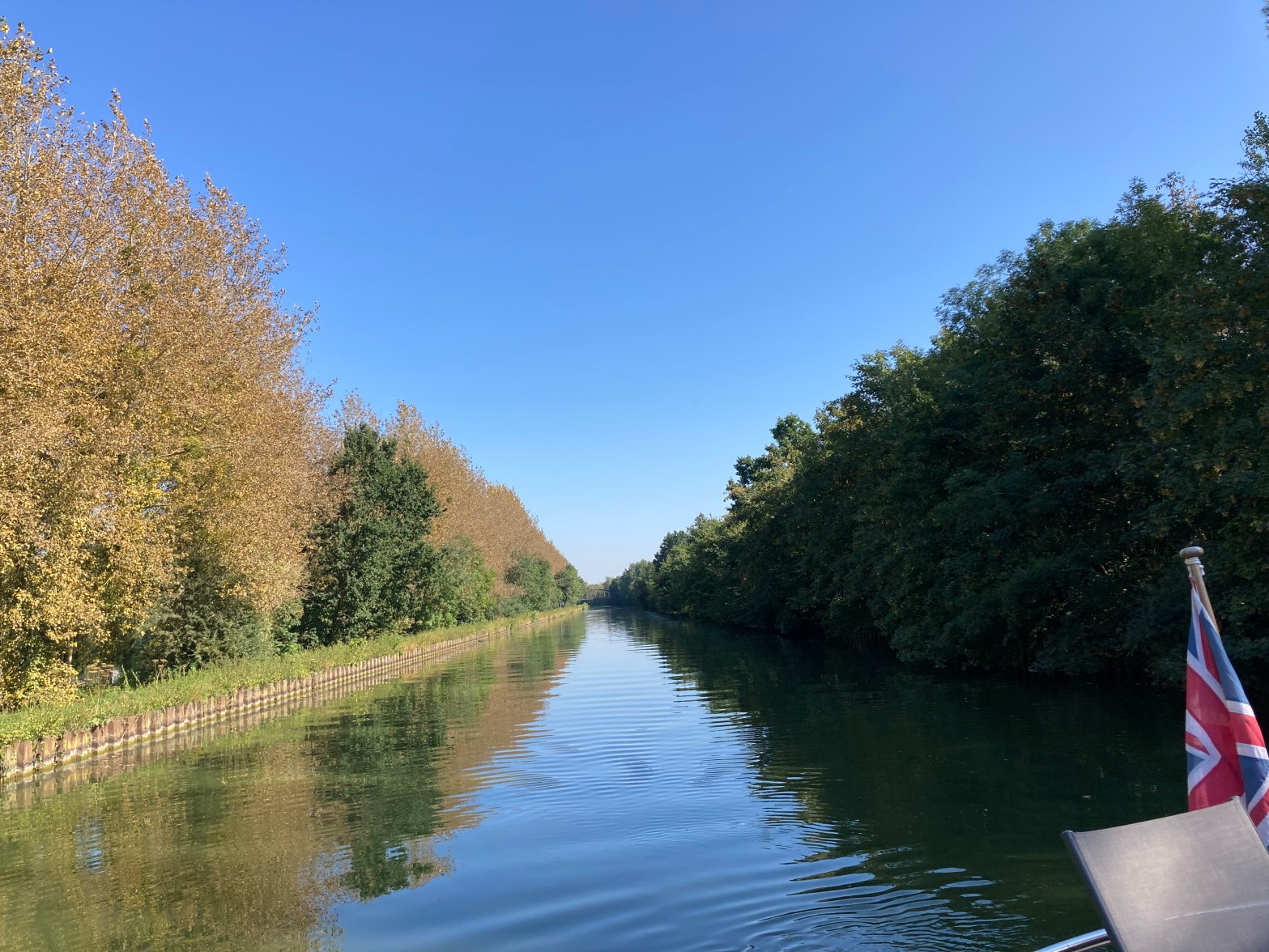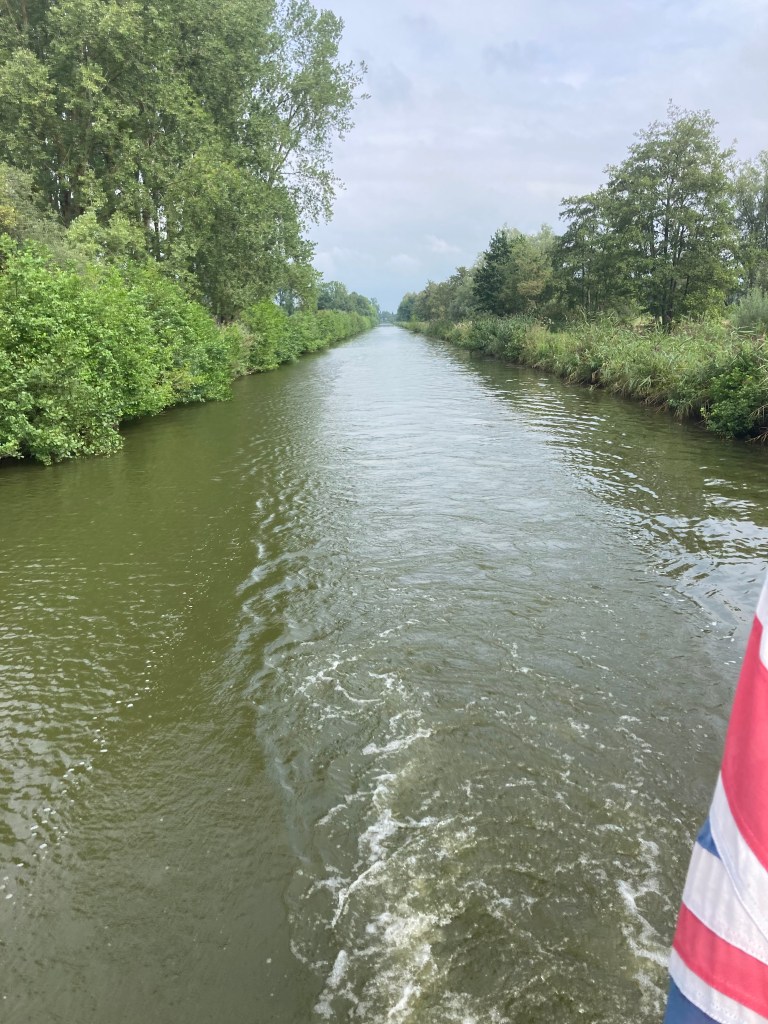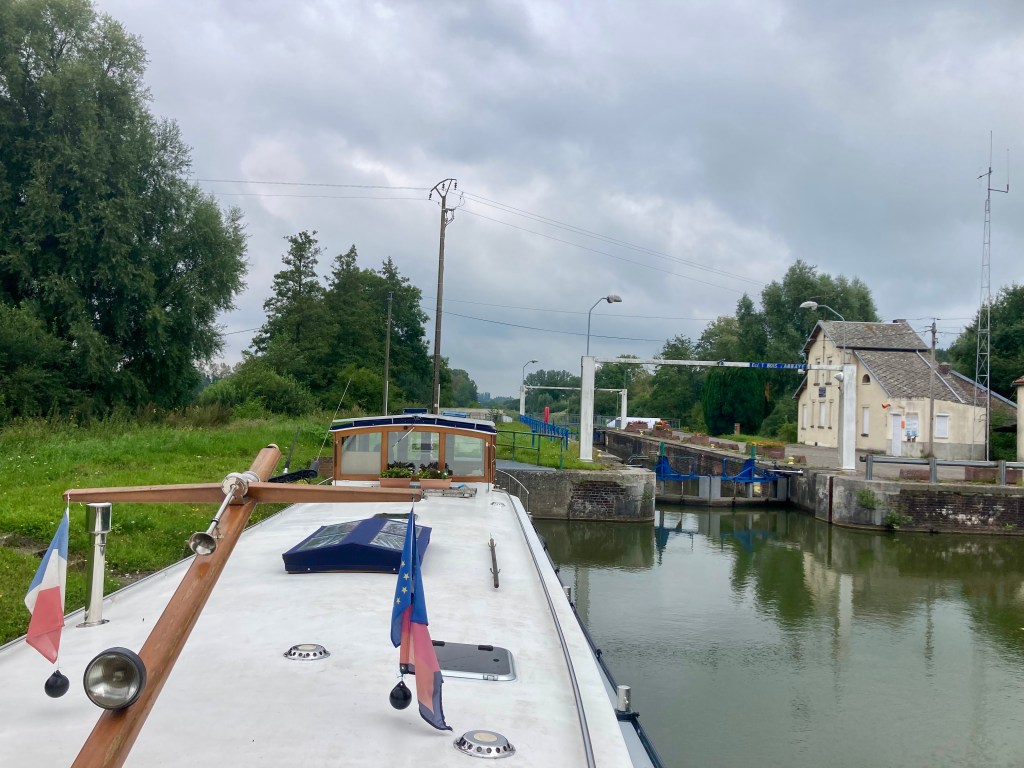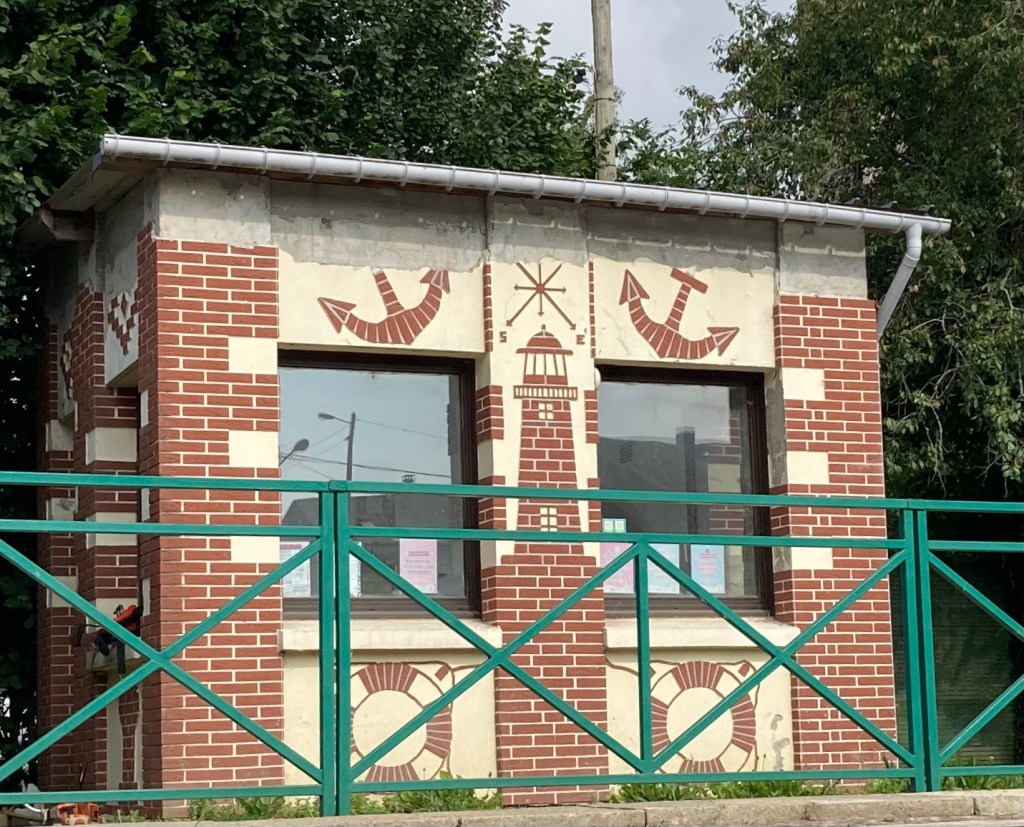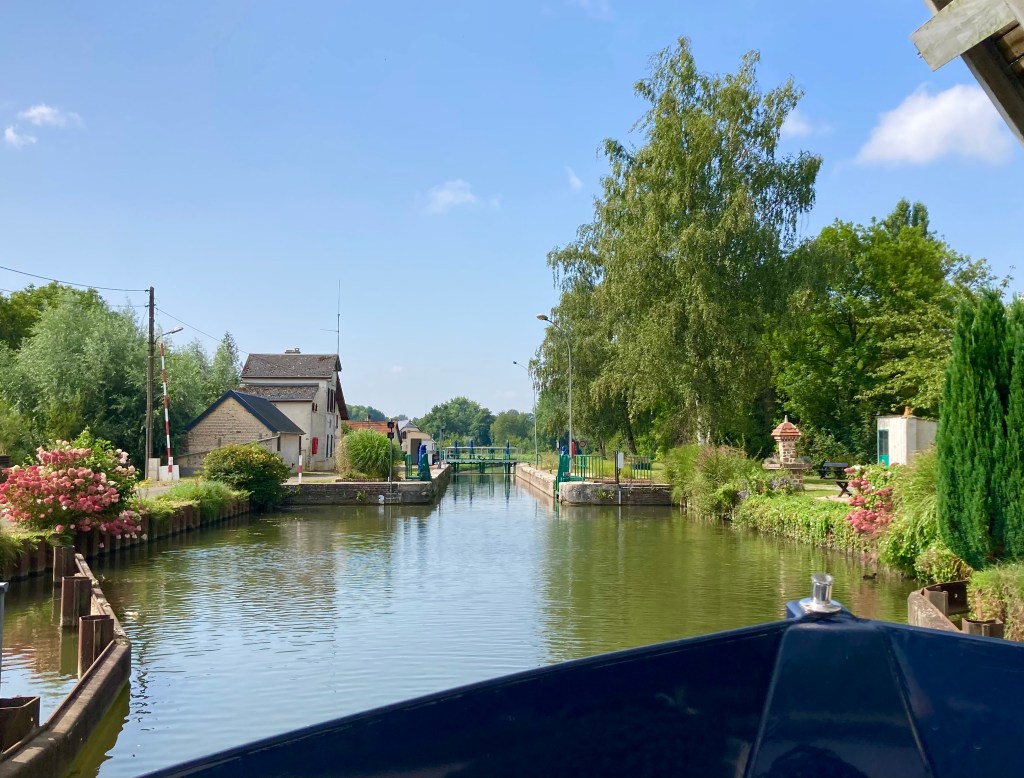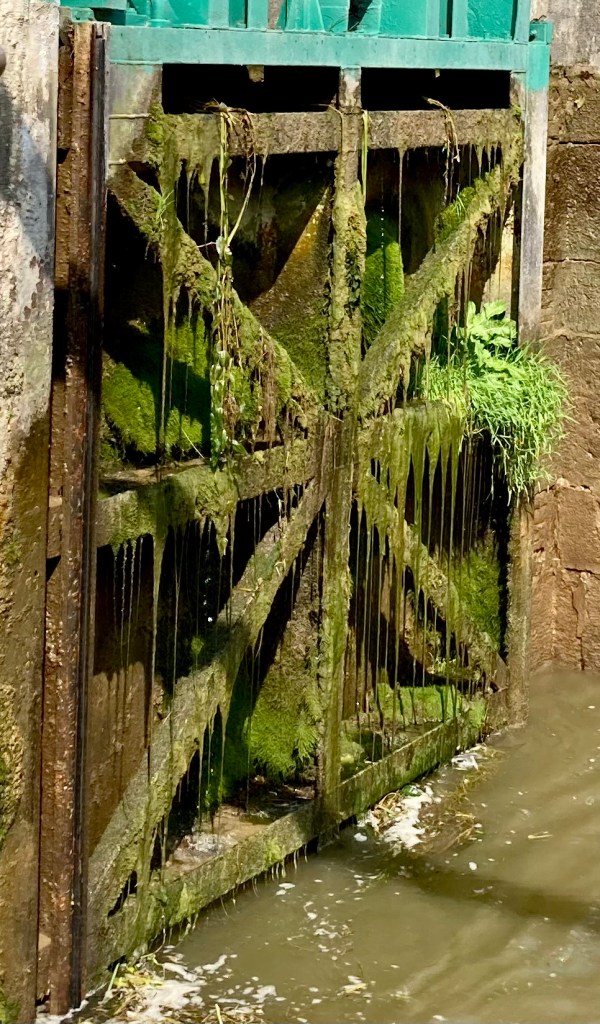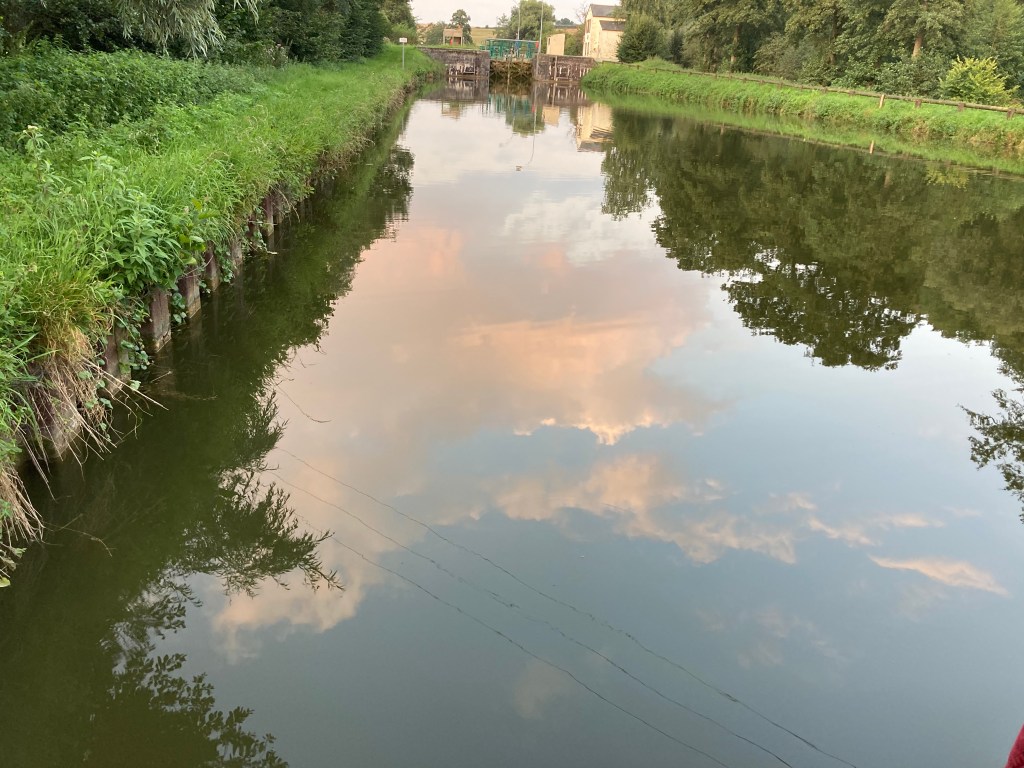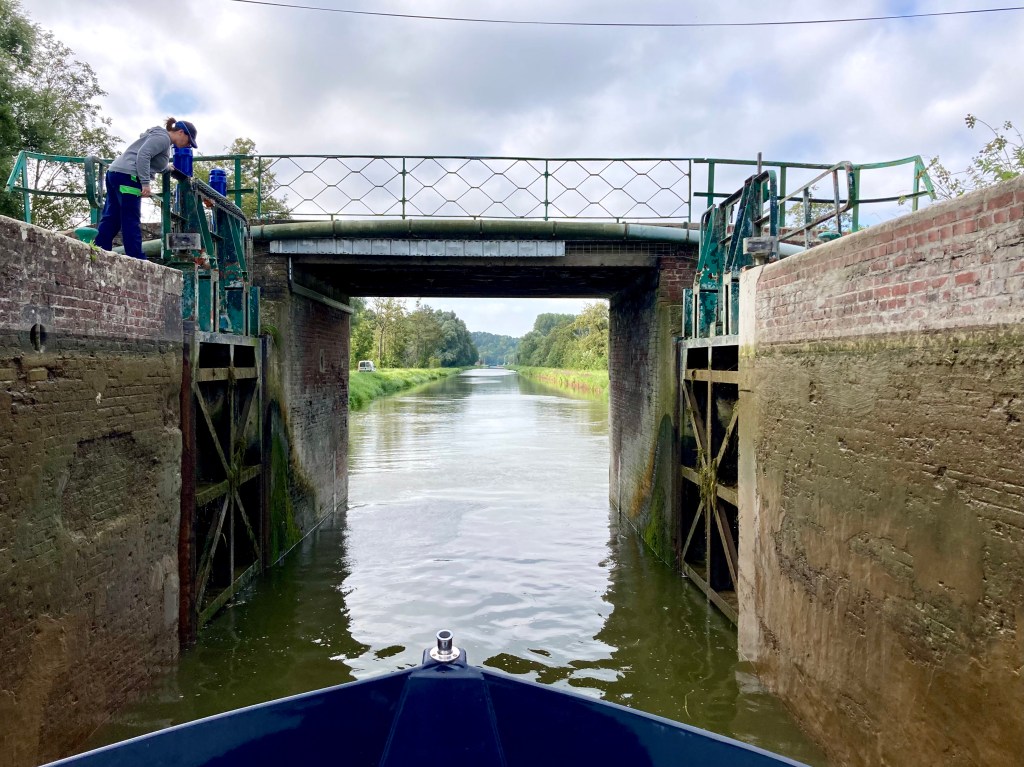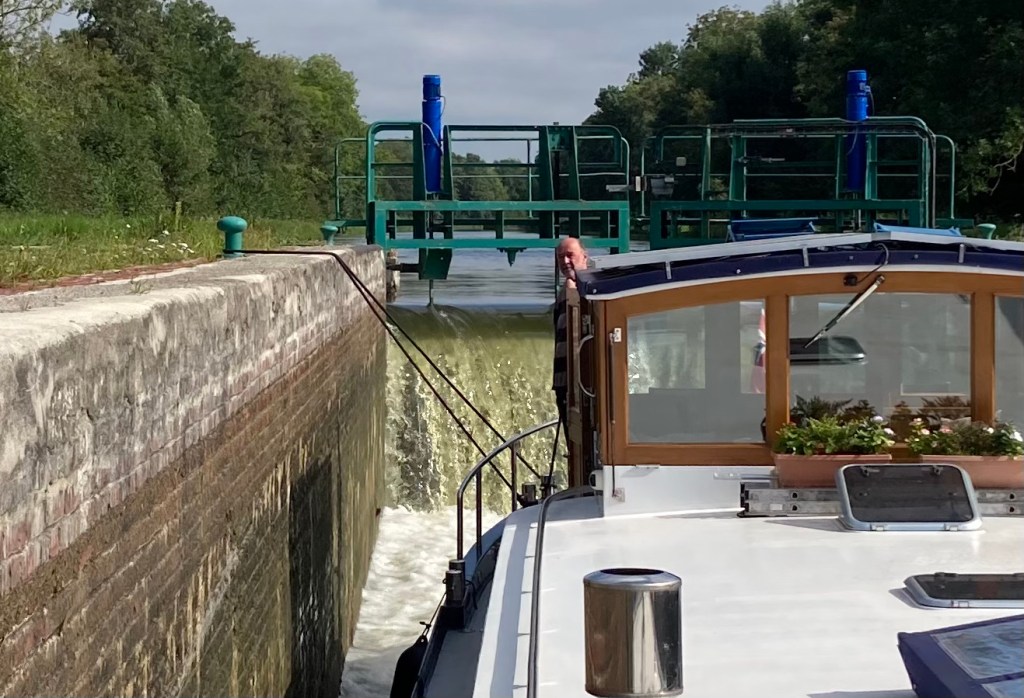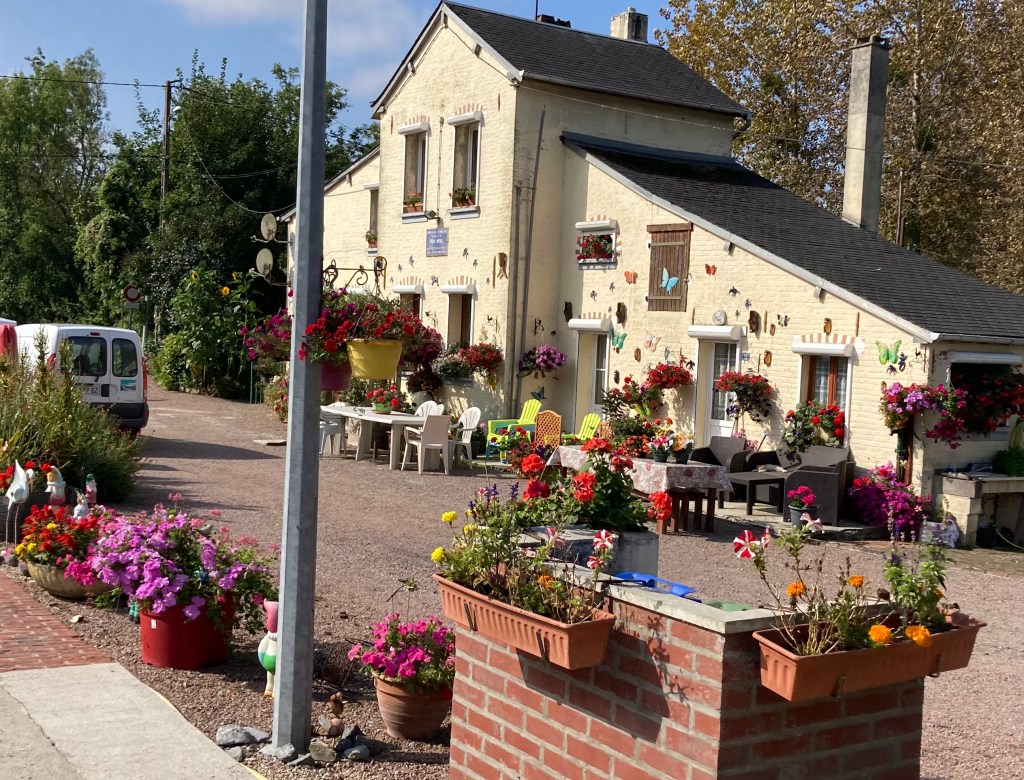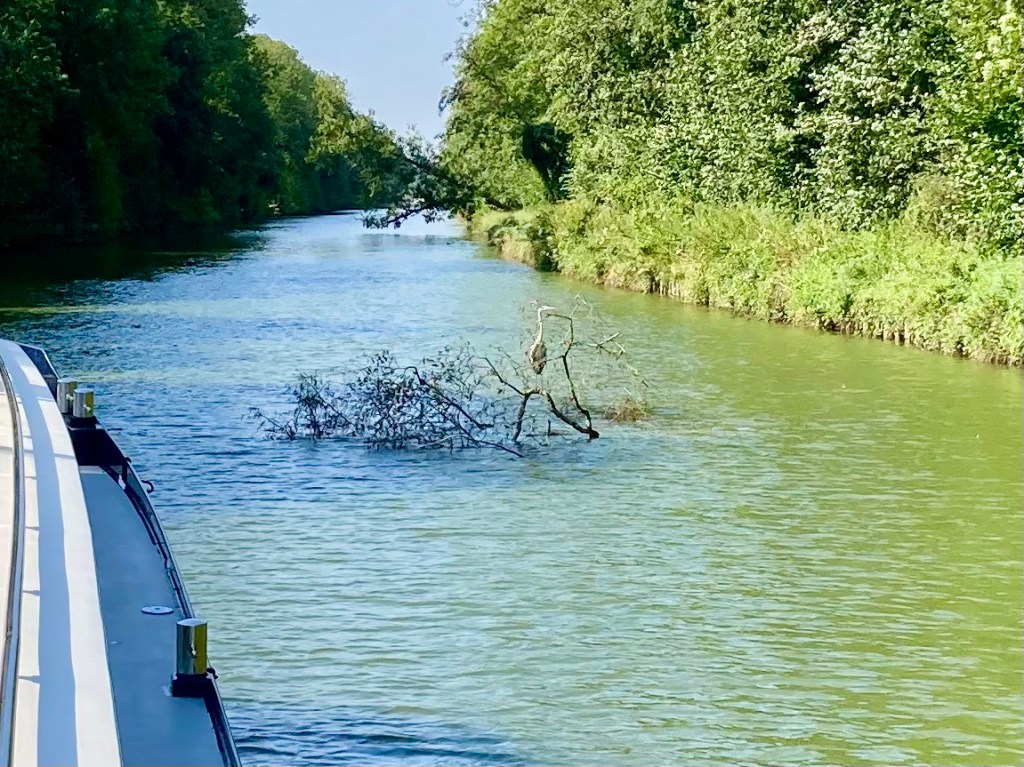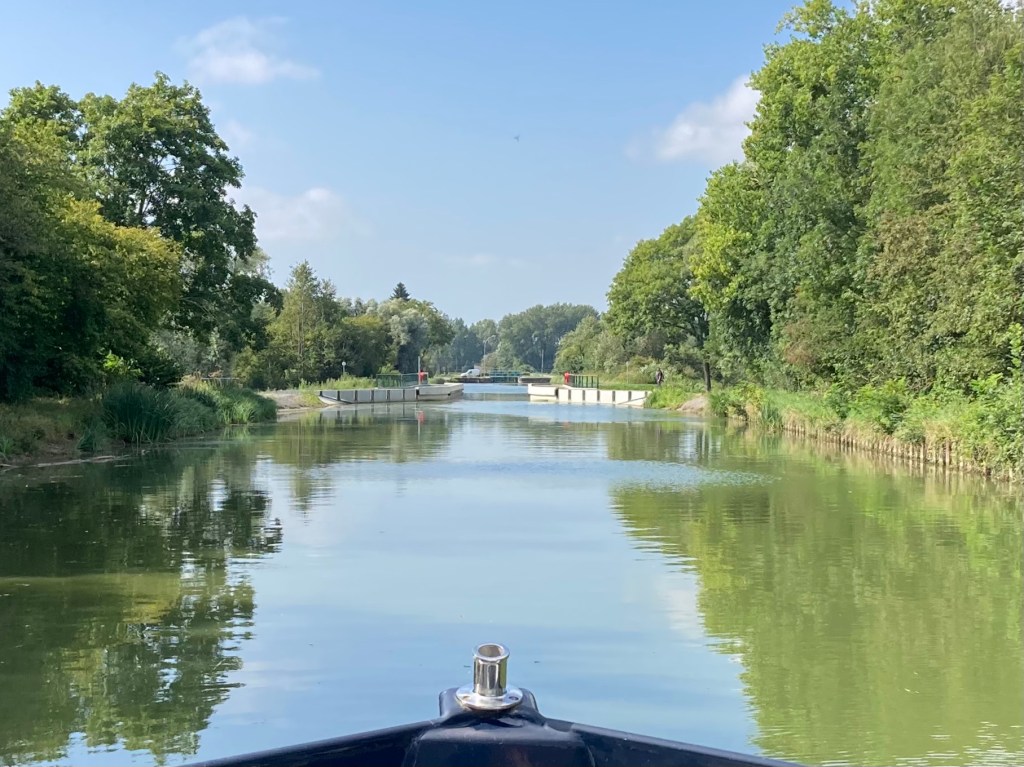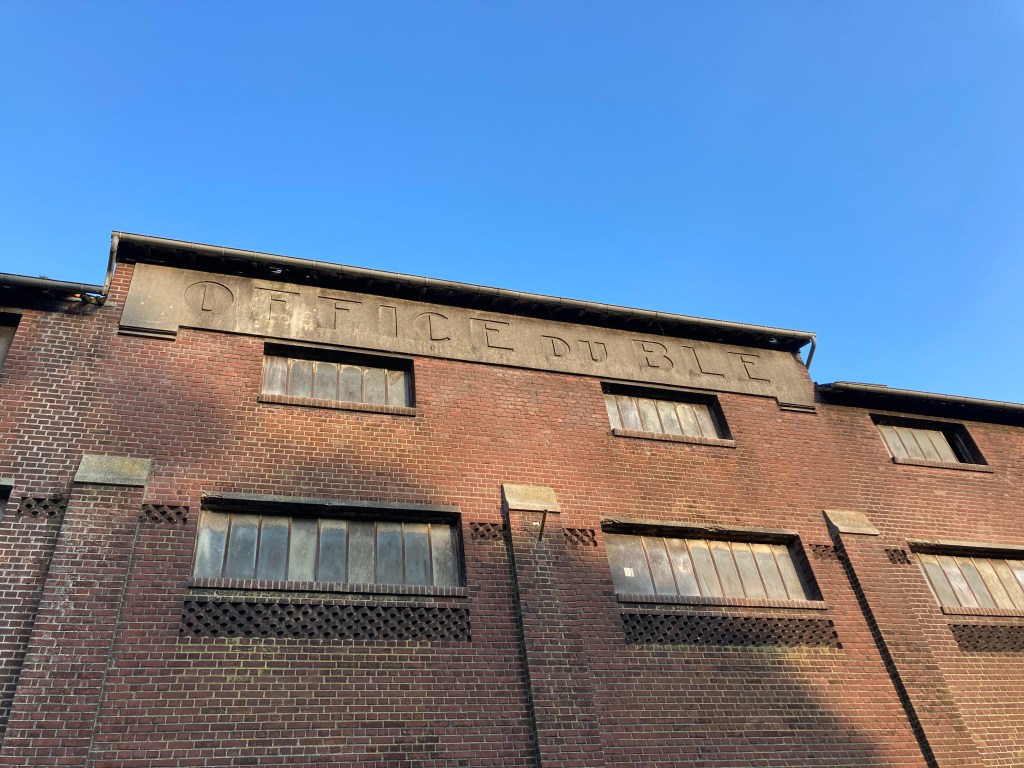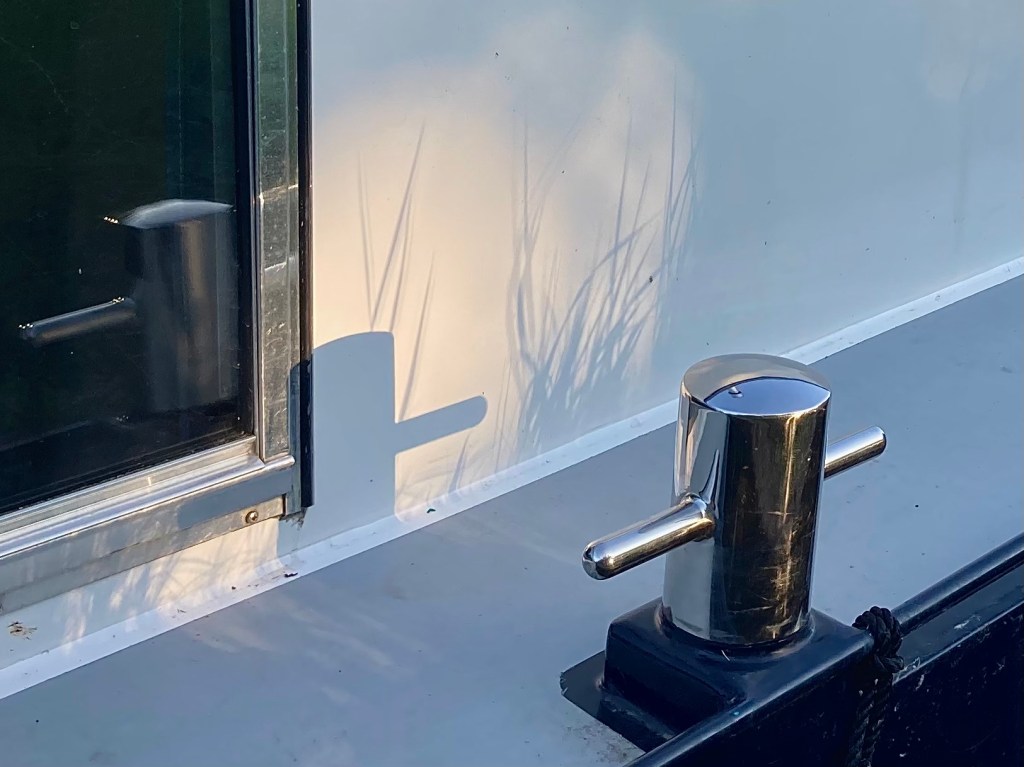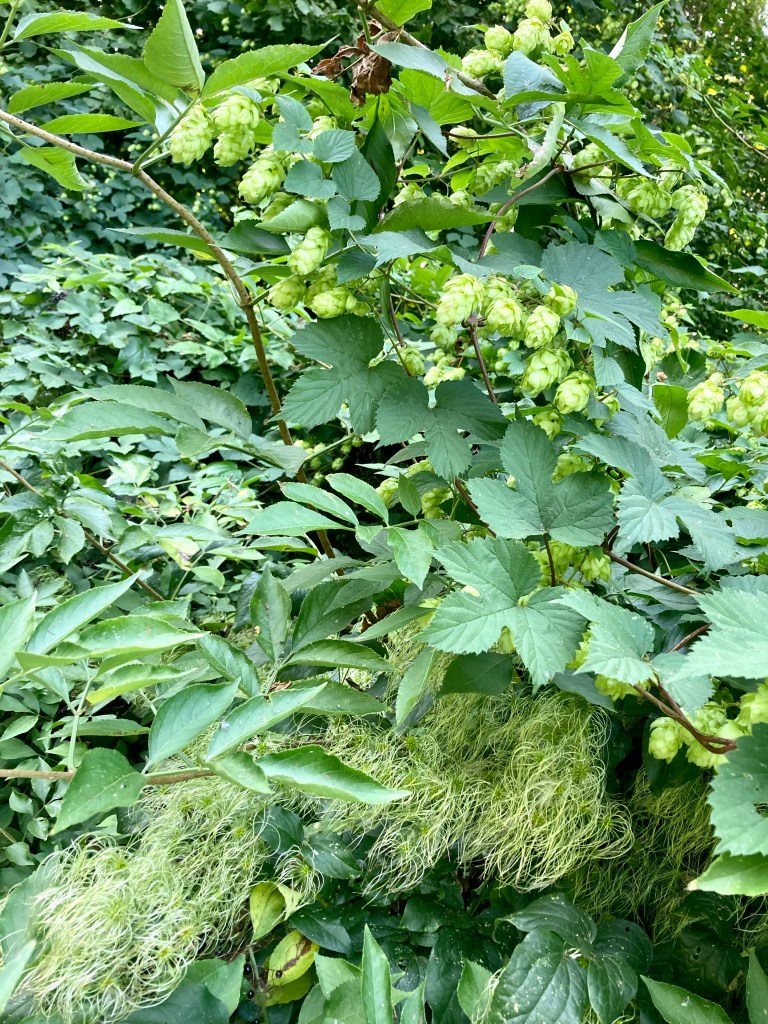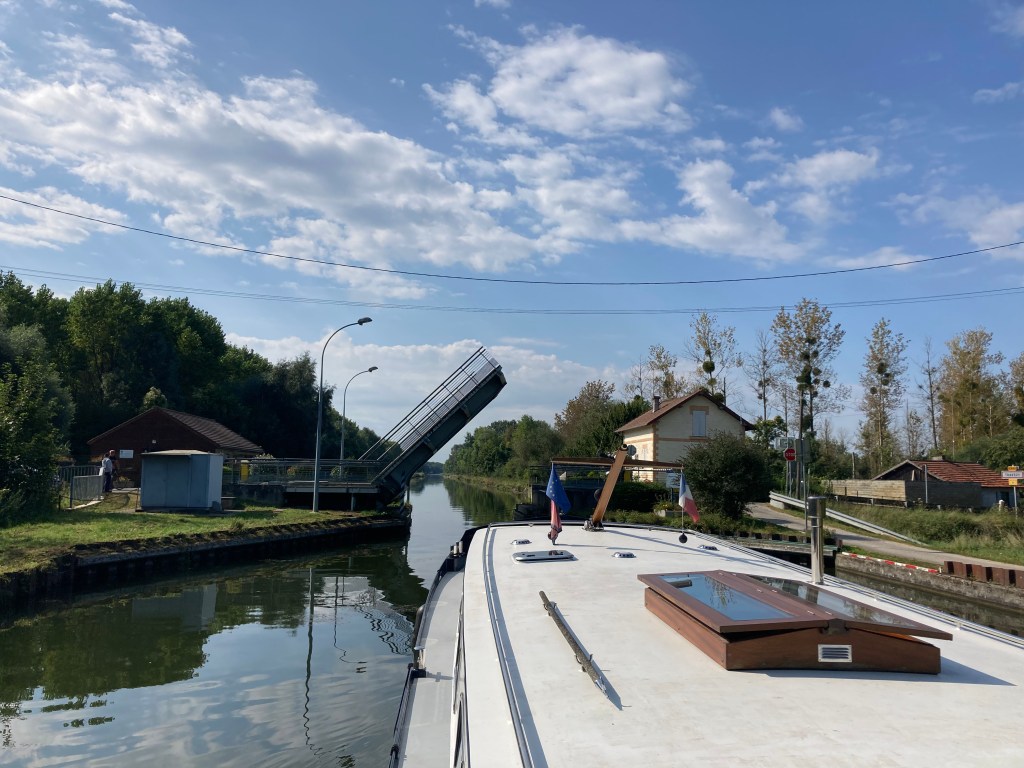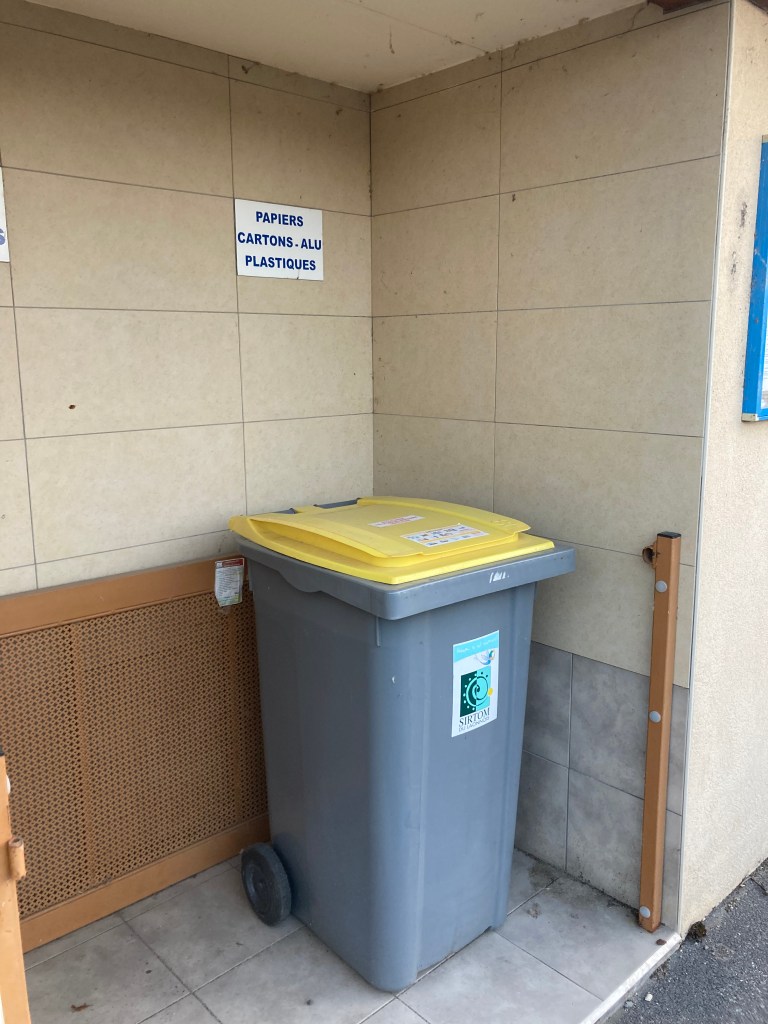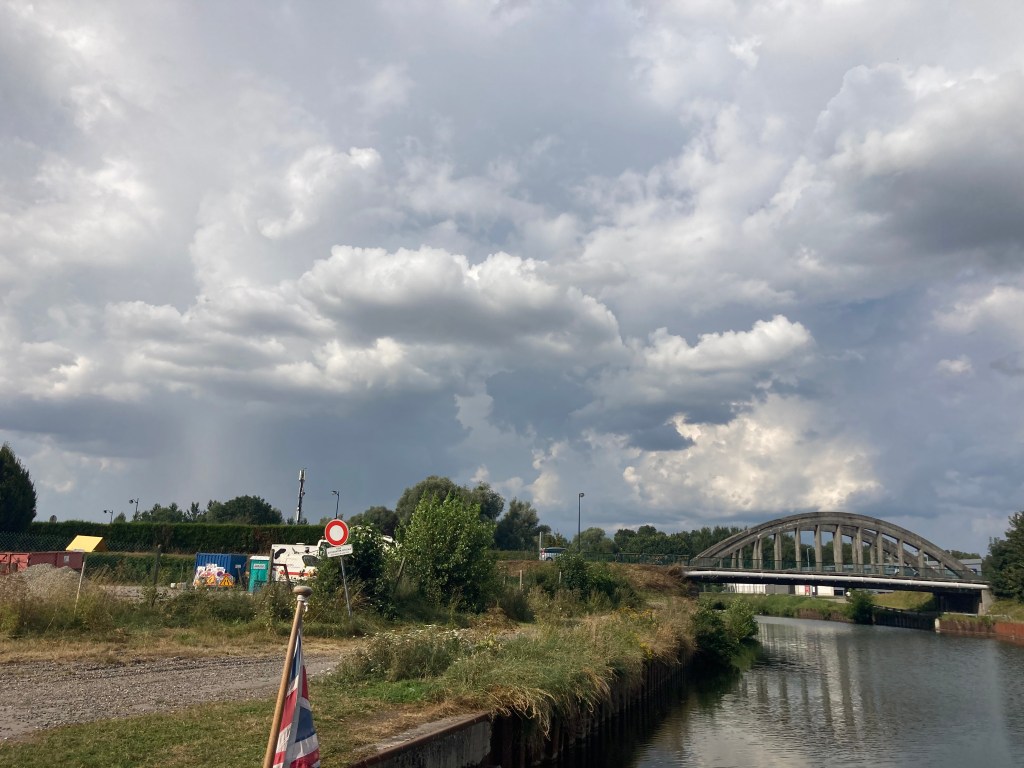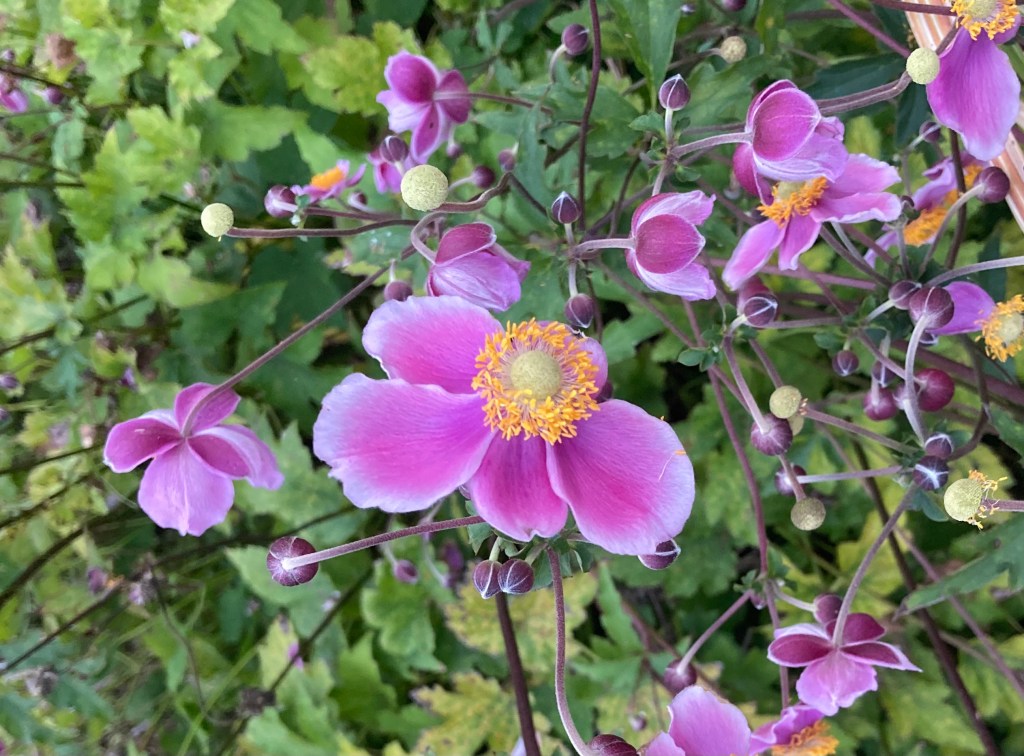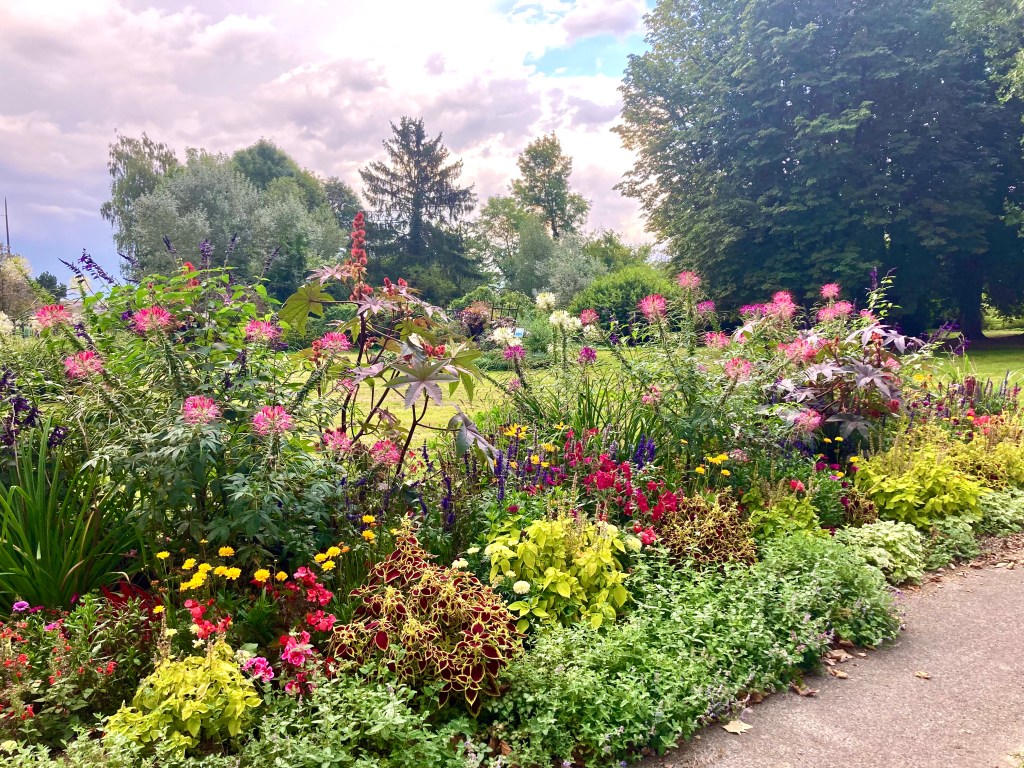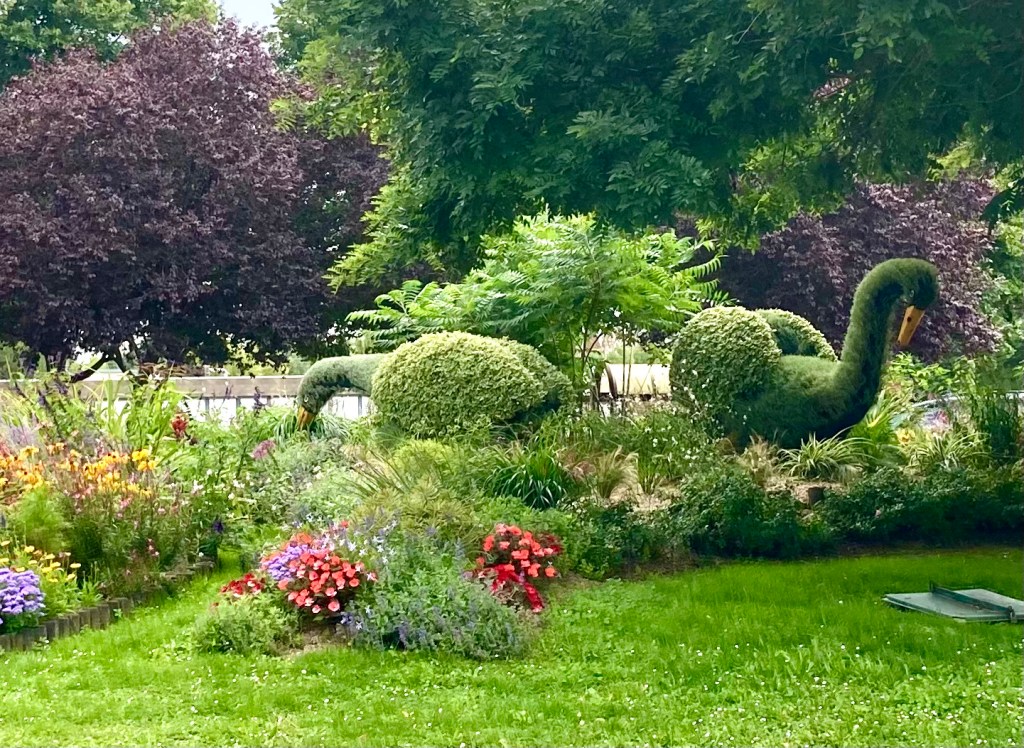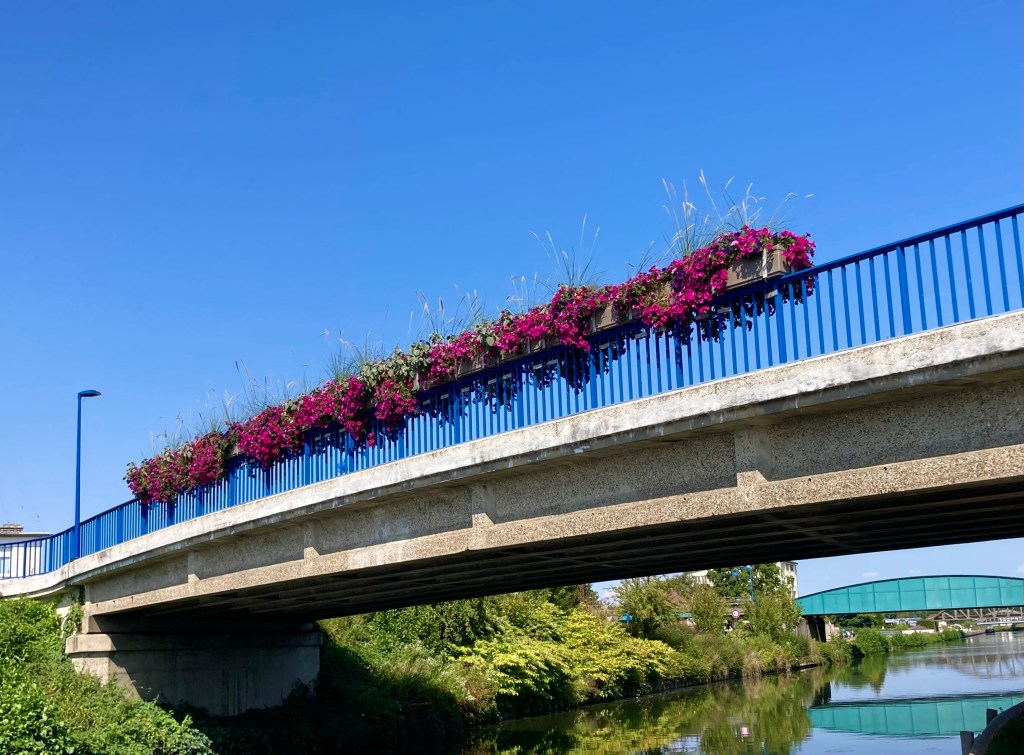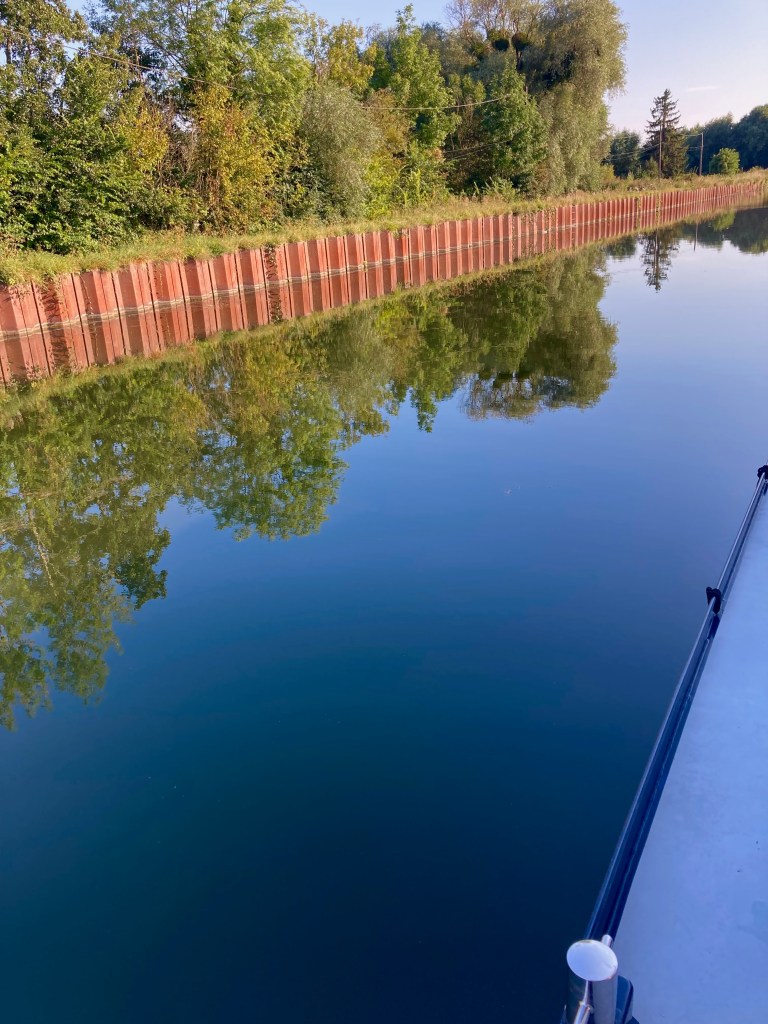A wonderful week on country waters
30th August – 5th September 2021
Robert Louis Stevenson was still with us as we moved onto the canal built in the 1800s to link the Sambre at Landrecies with the Oise at La Fère – both places mentioned by RLS in his book ‘An Inland Voyage’. To write in his marvellous style is far beyond my reach, but I will attempt to use a slightly more lyrical style to describe the people and events on this magically empty stretch of water.
(I am doomed to failure, but let’s give it a go).
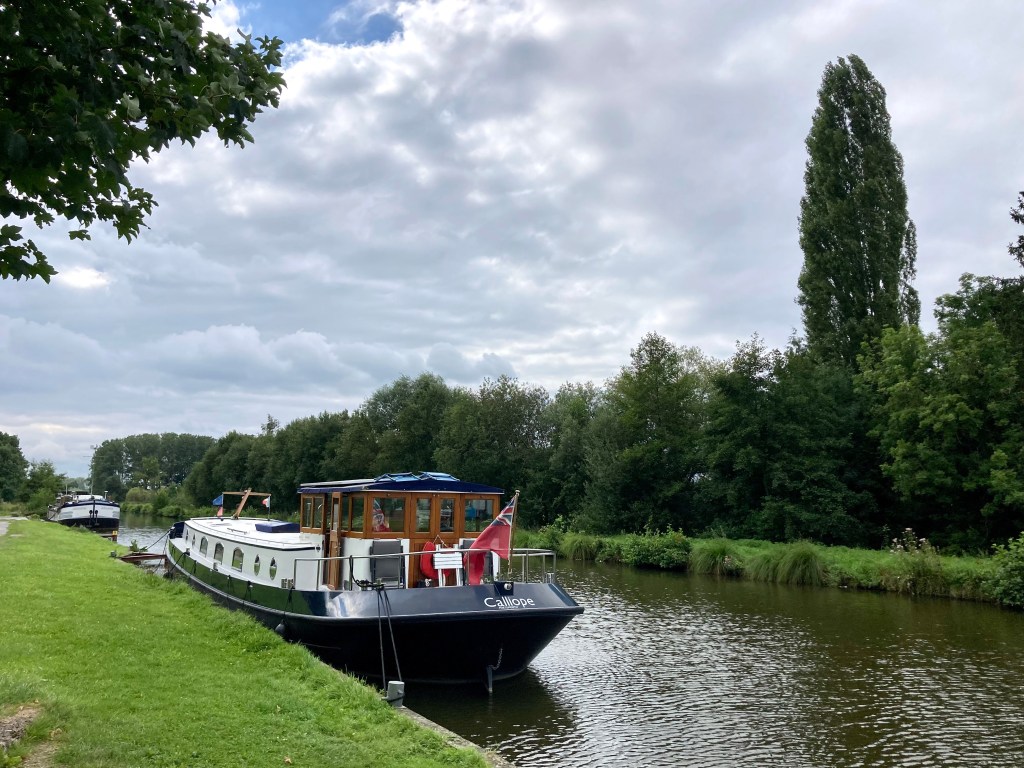
We left Landrecies with replenished stores – enough to see us through our week away from commerce, apart from the ubiquitous baguettes that we hoped to find from time to time. Luckily there is a fair size Carrefour just up the road – and they were selling off LOTS of wine before they changed to their new lines; Dame Fortune smiled our way.
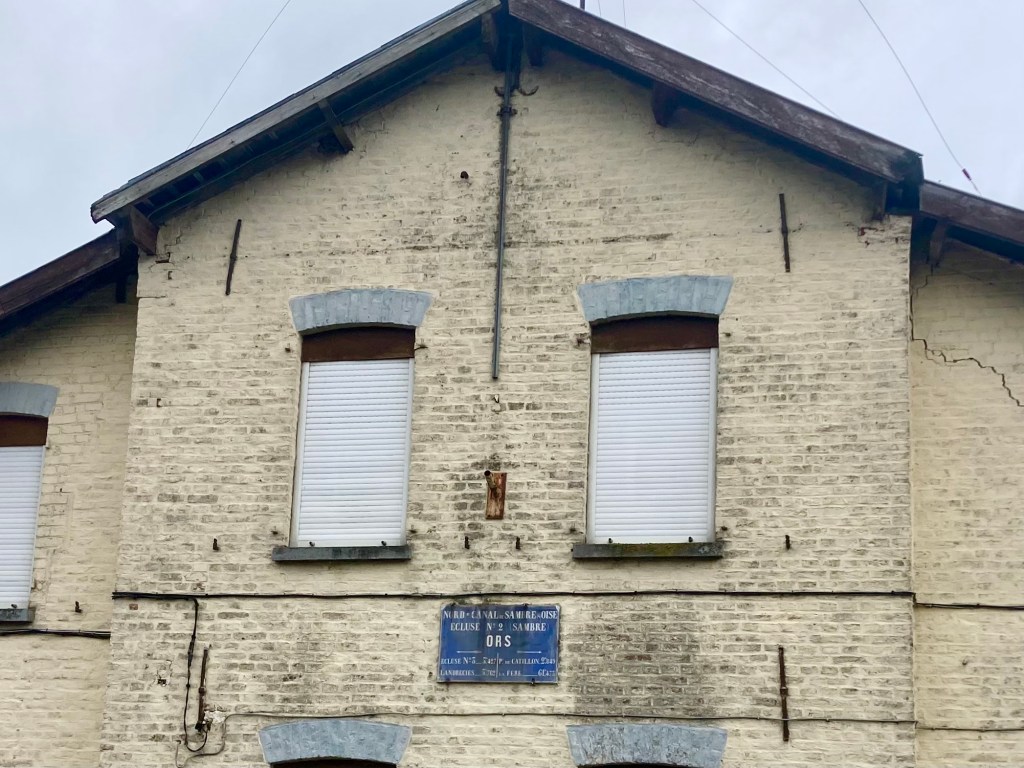
I had noticed the WW1 cemetery in Landrecies and then read how close we were to where the war poet Wilfred Owen died. He was probably killed crossing the canal on a raft when the allied forces were pushing back the enemy.
He is buried in Ors cemetery, close to Ors lock. Here is where his prophetic words came true:
“If I should die, think only this of me:
That there’s some corner of a foreign field
That is for ever England. “
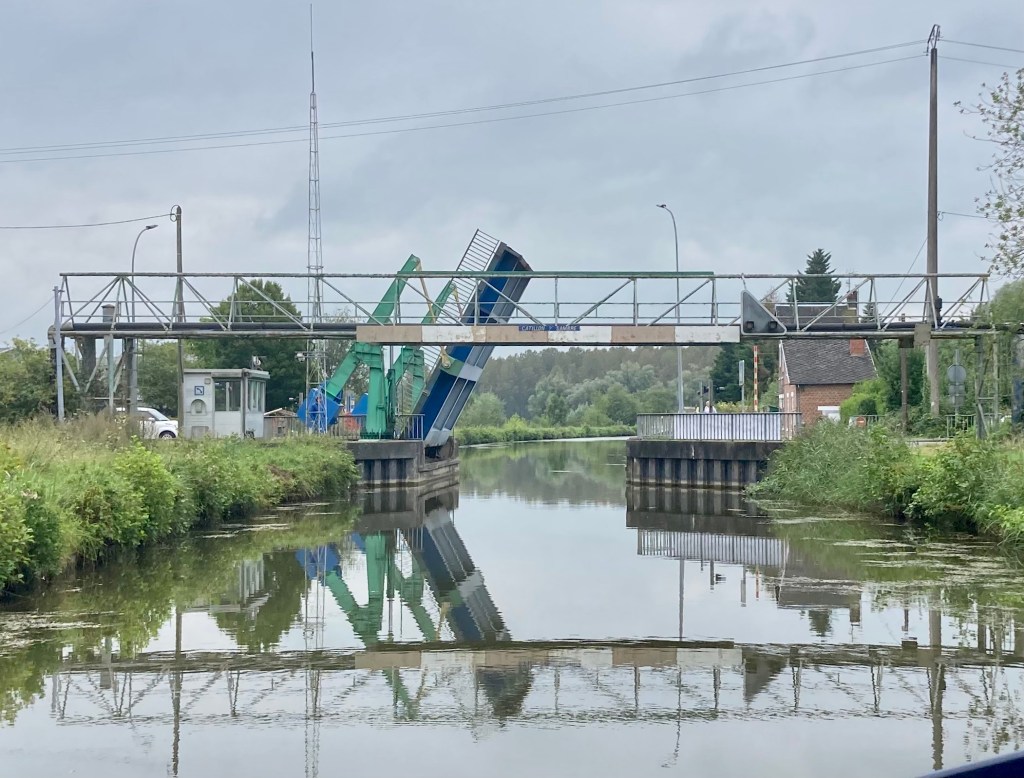
Soon after Ors we were at Catillon-sur-Sambre, trying in vain to use our zapper (remote control) only to see a helpful, seemingly happy, member of the French state waiting to lift the bridge for us.
Long may this last. I have tried to find out how many jobs on the waterways have been lost to automation, and how many lock keepers losing their lock side homes, but cannot find a source for that information.
In days gone by, now long ago, the bridge keeper would have worked from the brick hut on the right, and open and closed the roads and bridge by manual labour. Now he has a dull grey metal cabin in which to press his operating buttons.
We always hope to reach our next night’s mooring by lunch time, giving us the afternoon to explore the area. Such was the case at Bois L’Abbaye, the last lock on the Canal de la Sambre before it becomes the Canal de la Sambre à l’Oise. We knew that the mooring was by the lock, but were surprised by just how adjacent the quay was to the lock gates!
We came out of the lock, and with magnificent skill from the Captain, and of course some adept rope throwing from the crew, we moved sideways into moor. Engine switched off and absolute peace descended over us and Calliope.
Time now to enjoy the French rural life; lunch, siesta, and then a walk around the long fishing lake that we doisciver4d behind the trees, and which runs, hidden, along side the canal for two kilometres.
Bois L’Abbaye was also the place to say goodbye to our friendly zapper – the first we have seen that allows you to choose your language and then receive merry little messages to make your voyage easier. But good-bye it was, and into its little letterbox it was posted.
Next morning, ‘zapperless’, we continued on our way; next stop somewhere down a flight of 17 locks. The first 14 locks are within the space of 8 kilometres – and first we had to reach Étreux, the start of our rapid descent!

The cruise along to Étreux was smooth and uneventful, and we arrived full of interest and mild apprehension about what the next few hours would bring. The flags were out waiting for us, including the Union Jack, which has been removed from some flagpoles since Brexit.

It’s easy to see the long chain of locks on the map, some closer than a few hundred yards apart, but until you understand how it is all going to operate, and whether bollards are easily accessible, there is a feeling of ‘wait and see’ in the air. In this lock, number 2 I think, the ‘bollards’ in the wall to let ourselves down were cross shaped and not always easy to throw a line over, but as everything was slow and gentle it wasn’t a problem.
In fact it all turned out to be simple and straightforward. We were accompanied by a series of èclusiers who, like kingfishers, have their own stretch of the canal and will stay with you until the end of their territory – whereupon another takes over.

The VNF van with its accompanying éclusier was usually ahead of us at the locks, but on this occasion he arrived just as we were closing in on raising the operating rod.

And for those who are not familiar with these ‘operating rods’, here is a close up from an other lock.
(We did once, a long time ago, manage to pull the red alarm rod once trying to get balance and purchase on the green rod! Not a good idea – to brings all sorts of people running)
Our thought had been to moor up after lock 8 but we were speeding along so successfully that we decided to continue to lock 14. And just as that decision was made, and the canalised river took snake like turn under Vénérolles bridge, the water became very shallow on the inside of both bends! Captain Stu coped as always and we did not run aground.
By midday we were appropriately at lock 12, Hannapes. We enjoyed going through Hannapés, first of all with its lift bridge just before the lock, stopping the local traffic in its tracks for a few minutes – but not inconveniencing many! Someone has taken the time to create a nice garden be tween the bridge and the lock, and in fact around the lock itself. These little touches add to the enjoyment and variation of our travels all the time.
The second lock at Hannapés have me a chance to collect a little more lock nurdiness. The lock gates here are true natural moss gardens; I would love to spend time studying the various flora gathered on these gates! And the water levels along this stretch mean that almost as soon as the lock gates close behind you a waterfall starts to fall into the empty lock, sometimes threatening to drench the Captain who always has the stern rope!
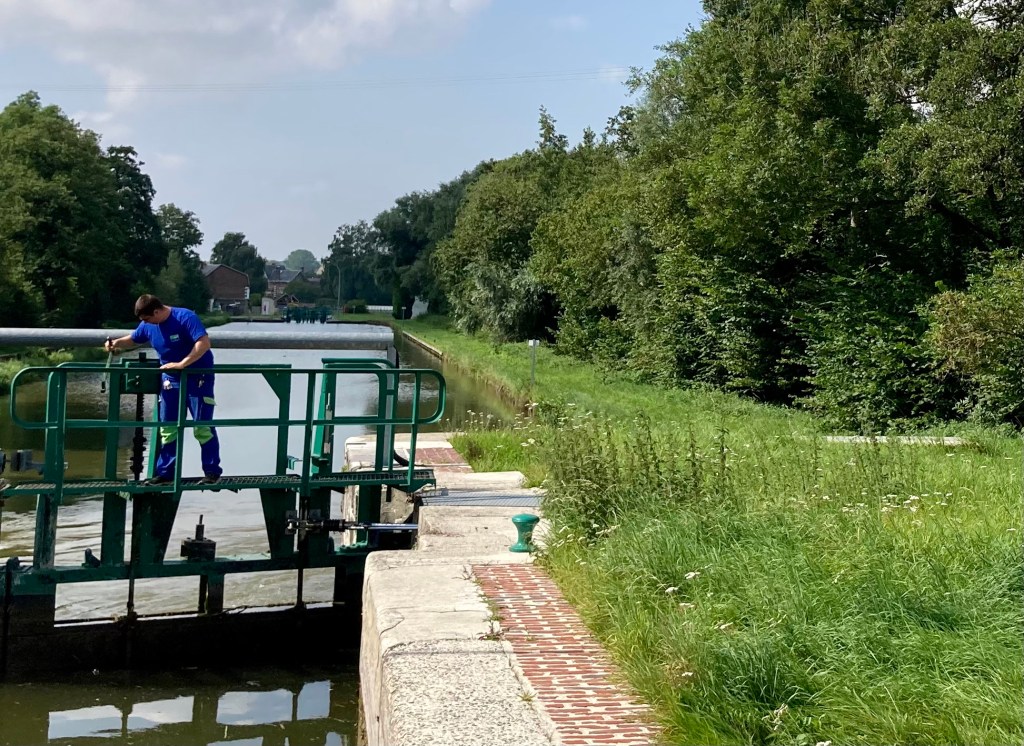
Finally we came through into Tupigny, where the young éclusier was reminded of the manual effort that went into the locks in the days of Robert Louis Stevenson! One vantelle (panel that lifts within the lock gate to let water in/out) had a problem with its automation and he was compelled to use the winding method of old – something with which that many boaters in the UK will be very familiar.
It was an hour past our usual lunch time, but we could see our mooring 100 yards in front of us, so all well.

I neglected to say that this day was the anniversary of the day we met, long ago at a folk club. So we were pleased to find an excellent solitary, legal, even romantic, mooring at Tupigny.
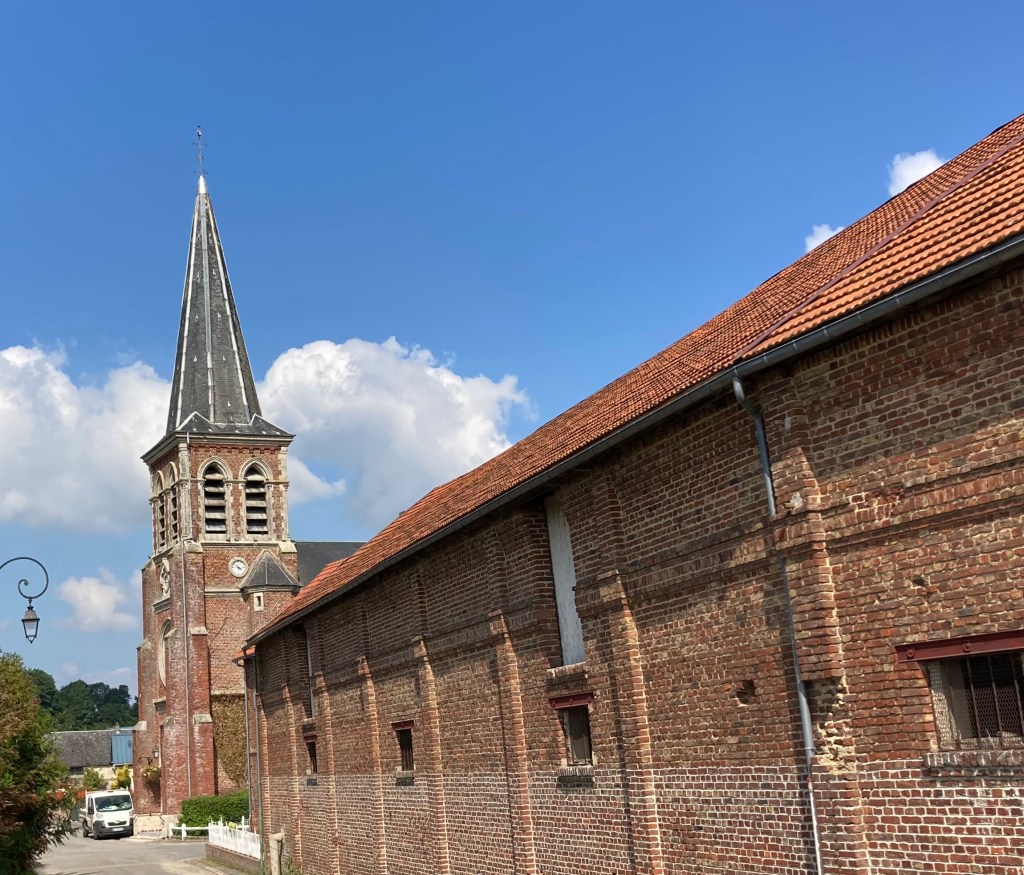
In the afternoon we walked round the village, slightly in hope of a bar where we could start our anniversary celebrations, But although a very well kept village there was no bar that looked to be open that day.
So we returned to the boat and had a wonderful home made tapas style supper on the back deck. And a gentle sunset to match the rosé. What could be better?

As we left Tupigny next morning we saw some of the work that is still going on on this re-opened river/canal to modernise it.
Here a swing bridge is being replaced. Looks like it will be completed soon.
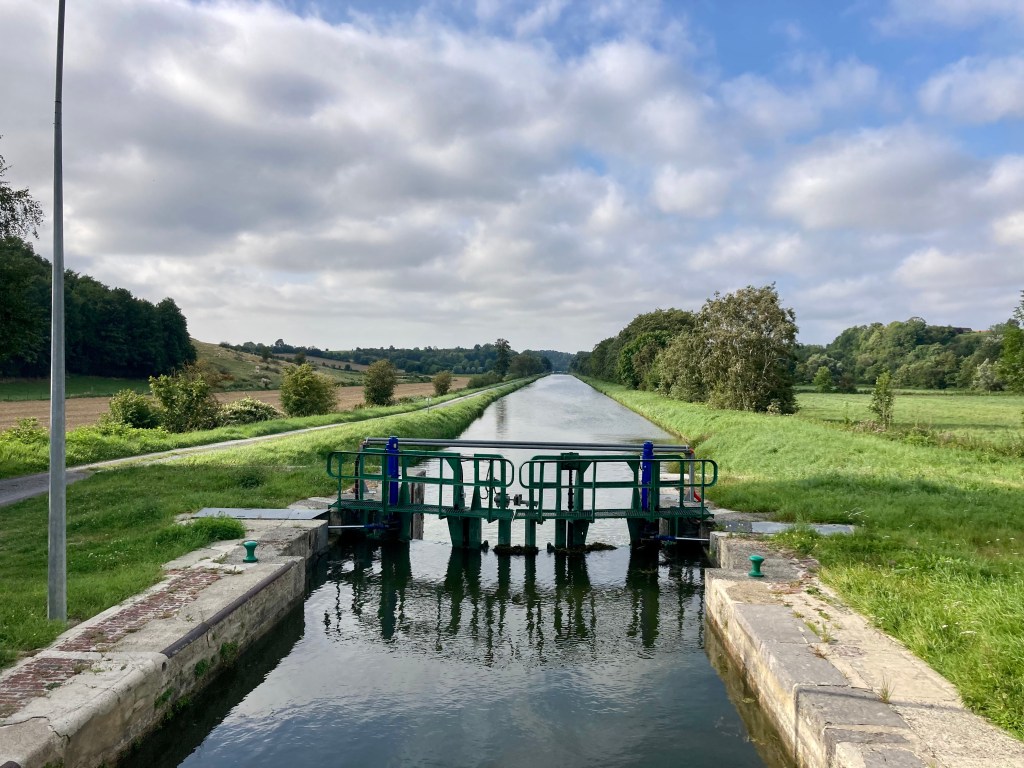
Out of Tupigny and back out into the country, with a straight run down towards the second Grand Verly lock. These wide open spaces, with the pastoral hills beginning to rise around us, never cease to fill us both with natural wellbeing – our form of mindfulness I guess.

The main reason for the 14 year closure of the Sambre mentioned earlier was the failure of two viaducts at Vadencourt and Macquigny, shown by the two red ‘no entry’ marks on our map, and both now rebuilt thanks to a €30m investment shared by the French government and various local authorities.
So here we are arriving at the first of the two new pont canals; very smart! And over one of many many loops of the Oise we go.
Of course the locks along this stretch were out of use for years. They all seem to have had a new coat of paint in VNF blue and green. And the house Lock 21, Proix Noyales, has been turned into a lovely home and garden. I wonder how they feel after all the very quiet years to suddenly have boats full of people coming by.
The local wildlife are also having to get used to boats appearing from round the bend! A branch rather awkwardly placed for barges has been a good fishing spot for this heron until we arrived.

Towards lunchtime we were approaching Origny-Ste-Benoite – our mooring for the night. The initial view looked somewhat industrial, and turned to to be a major sugar factory, utilising sugar beet from a huge surrounding area.
Even as we came to and through Oriogny lock we were wondering why we had chosen Origny – the one;y place we could see to moor being ‘underneath some HUGE silos – but we tied up, had lunch, and looked around!
We were on one side of a huge empty basin on a quay unused apart from the grain-watching pigeon collection! Lorries came occasionally at the other en d of the quay to deposit their load, and a tractor passed us by even less often – so amazingly peaceful given the setting. And when they all went home for tea, even better.
Moy-de-l’Aisne

The next day’s morning sun lit up the saloon and galley magically, getting me up and going.

I returned to both the previous day’s boulangeries, hoping to find quiches in one of them . (I have now learned that am more likely to find a quiche in a butcher than a baker … so expect sweet things plus bread in a boulangerie and savoury ready to eat delicious meals, plus raw meat, in a boucherie.
Anyway I did find bread for lunch and a huge pain au chocolat which seemed to be a perfect breakfast.
But there are chances to live on these lock houses. Usually you cannot buy them, but at a peppercorn rent you can enter into an agreement to do it up at your own cost.
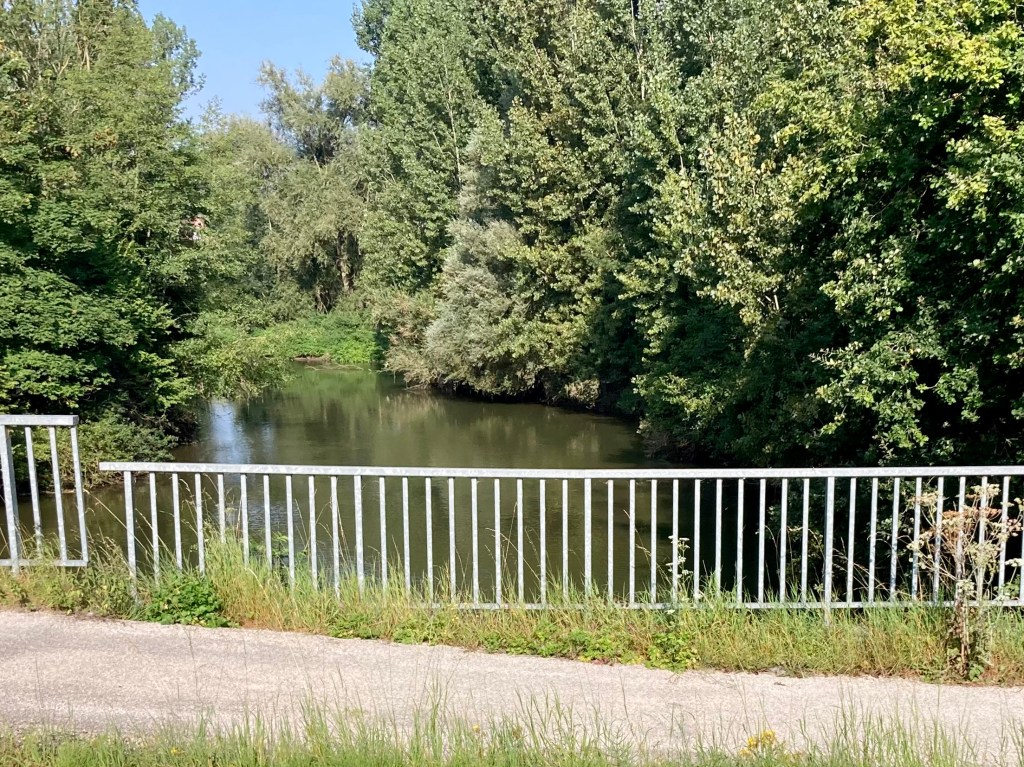
As we moved on down to our next halt I was reminded again of RLS who, apparently, almost got sucked into a ‘siphon’ under this pont canal. He was on the river underneath where it flows through a series of holes in the structure, rather than a full river.
He was alerted by someone on the bank and avoided getting jammed, with his canoe, under water!
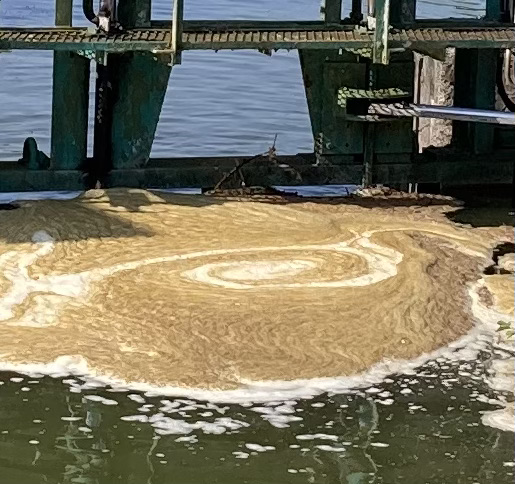
Another sense of wonder along the way was the cappuccino style froth in some of the locks. I am sure that the brown foam is somewhat dirty, but the overvall effect is very stylish!
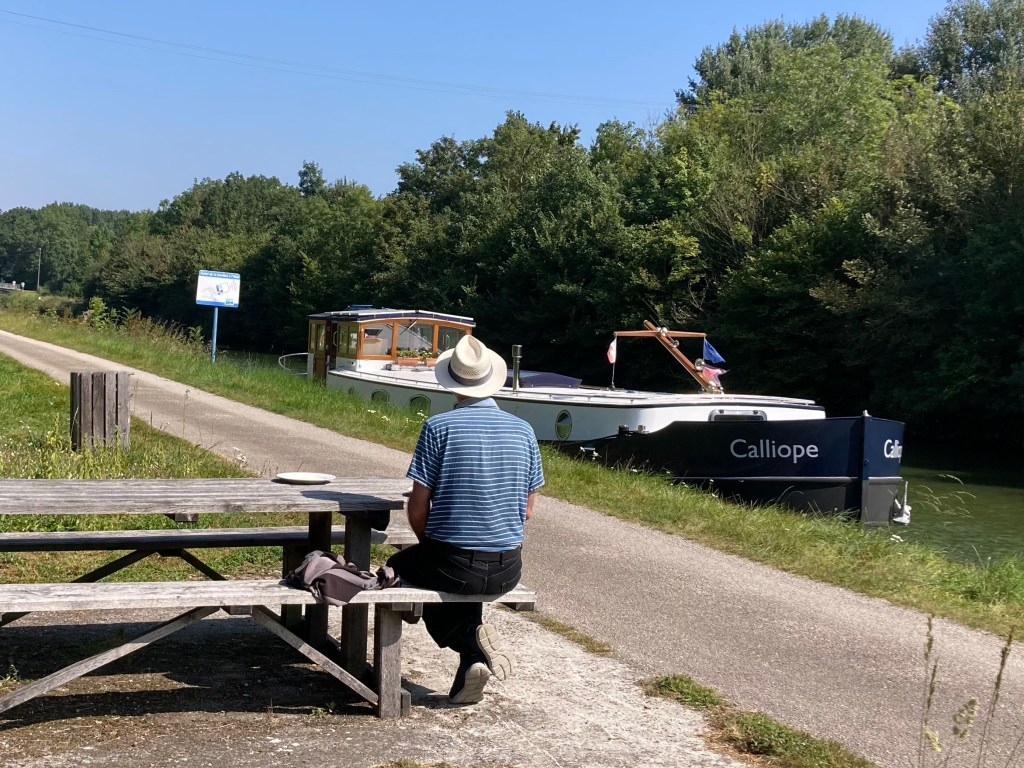
We arrived, stopping just below Hamégicourt lock, to just what we had hoped for – and even an empty picnic bench waiting for us to have al fresco lunch. Happy Captain.
We had our customary walk – this time a kilometre into Moy-de-l’Aisne – and found that RLS had got there first! He had enjoyed watching people going in and out of the moated chateau – unfortunately destroyed during the First World War. And he stayed at the Mouton D’Or – also no more! There was evidence of confident building after the war; many houses had towers, steeples, and echos of chateau style decoration.

As we came through Hamégicourt lock the man who now lives in the lock house(a retired lock keeper we later discovered) emerged to say hello and watch Calliope descend.
I used my best French to say how lucky I thought he was to live in a lock house, and he replied that he thought I was lucky to live on a boat! He invited us back to see his little secret garden later.
So we did – and discovered that we were in the presence of a sculptor of some renown. His stable is now a workshop, and full of dustcover cloaked pieces of his art. He is a very private man, so I am not showing his work or his name, but here is his barbecue – sculpted out of various old objects and built to the right height for him to cook.

And he was delightfully kind in giving me a present from the wonderful collection of dusty antiquities he had stored in his workshop.
This little tin ‘bath’ is now mine and will for ever remind me of our stop at Moy.
That evening the quietness, the light, the sound of birds – all combined to make it one of the gentlest evenings of the summer.

But that was before we travelled a full 2 kms to Vendeuil, even deeper into the country, even more peaceful. Even now, writing this, I shake my head in wonder at the perfection of the place.

Vendeuil – here we are, moored tip on a hot day in the shade of trees next to a field of rambling cows, moving together in synchronised grazing. I think a very few cyclists went past, and one boat gong in the opposite direction – a real shock as we saw so few other craft on this canal.
There was the scheduled walk in the afternoon. A long lake runs alongside the canal at this point – no doubt a stretch of the troublesome run-away Oise. We had hoped to get down to it, but it was a private fishing lake so we just enjoyed the view. We were surprised to see a lot of wild hops growing – normally hops are grown in Alsace.
We had a wonderfully dark and peaceful night, expecting it to be or last on a tranquil mooring for some time.
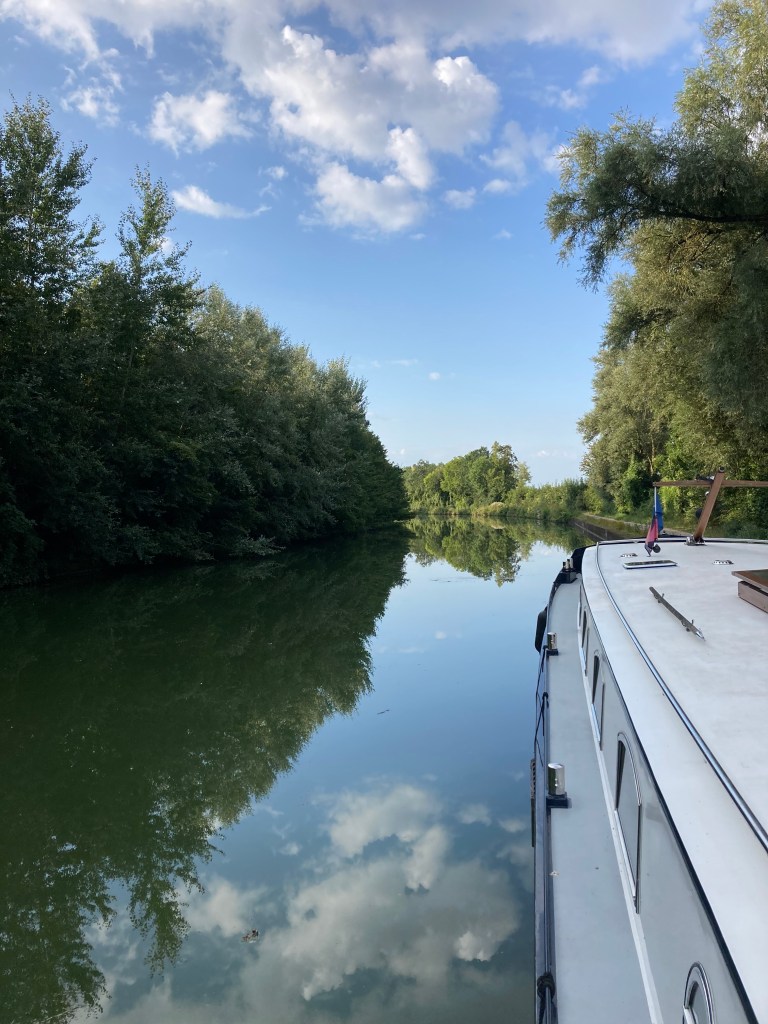
On Saturday 4th September, two weeks and two days after entering the Sambre at Charleroi, we were leaving this scenic waterway, heading for Beautor and within three and a half kilometres of this canal meeting the Canal de St Quentin – another story!
Our three hour trip included a complete change of lock style for the two locks at Travecy, with these recessed blue bollards – very smart and easy to work with. There was also nice green growth on the second lock wall – hanging gardens of Travecy!

We waved goodbye to our new friends at Travecy, and also to our last Canal de Sambre à l’Oise lock – a sense of the end of a journey – the end of our heading South.
Time to veer slightly West before heading back north for the winter.

The mooring in Beautor – along a huge empty 100m+ quay, was much nicer than we had expected. And nicer than this photo suggests.
It was very quiet – some traffic across the bridge behind us, but not close enough to be troublesome. Otherwise a quay that rarely had people or cars on it, with a bank opposite that was an isthmus between the canal and the ever wandering Oise.
Nice enough to attract a few cyclists and dog walkers.
So nice that we stayed two nights.

That afternoon we needed to do a quick shop at the LeClerq supermarket, a convenient 500 yards away.
It was hot, but had to be done that day as the shops were shut on the following day, Sunday.
When we returned, fully laden, the locked up wheelhouse had clocked up a magnificent 40 degrees C!
But all cooled down with doors open and a sun setting earlier now that we were into September, and a change in the weather!
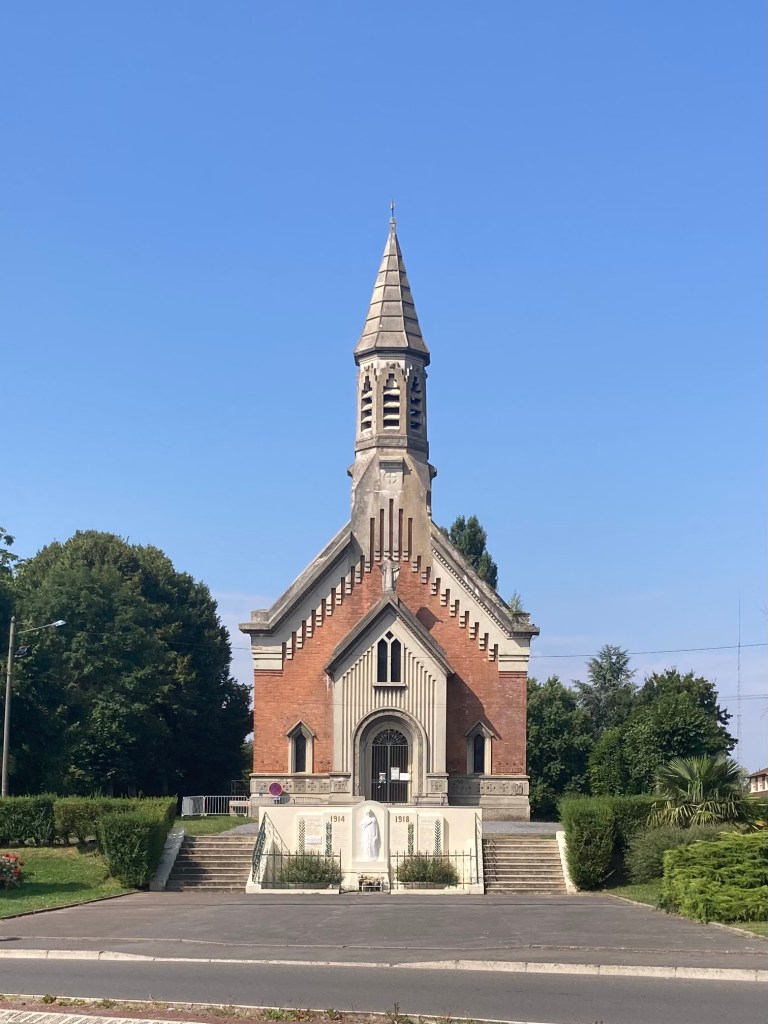
The route to Le Clerq took us past the church – an art deco building that couldn’t help but grab our attention.
I wish now that I had gone inside too – I wonder what it is like. Google will help me!
The heat caused billowing clouds to gather, thunder to roll, and eventually rain to fall; a sweet half-rainbow appeared too.
The following day we had a good walk round La Fere, the historic military town across the other side of the canal. It is another of the places where RLS washed up and has quite a bit to say about the number of soldiers and reservists in town. Now it seems to be entirely civilian.
But there are huge remnants of the military presence – magnificent in their grandeur and might!

and parts of the old town, although tired, are still fascinating.
Streams and tributaries of the Oise find their way between streets all over the place!
The two towns of Beautor and La Fere have gone to great effort to be Ville de Fleurs. Everywhere possible are huge and colourful beds of flowers and grasses. Boxes adorn every surface and most lamp posts have their own min-garden! I bet it wasn’t like this for Robert Louis.
And more! I took even more photos so I am treating to you to just a few of the many.

The walk to La Fere also resulted in bread for lunch. We were ready to eat to when we got back from our exploration.

I was still keen to have a better understanding of the wiggles of the l’Oise, so took a walk along to the next bridge, over, and back along the other bank – where I found the Oise curling round just a few feet away.
RLS gives wonderful descriptions old the tortuous meanderings of the river, always rushing in haste to the sea, so it is nice to get a sense of his experience.
That evening the effects of the sunset were spectacular. Our last night on this totally stunning, completely absorbing, very relaxing and tranquil waterway – La Sambre and the Sambre à l’Oise Canal.
